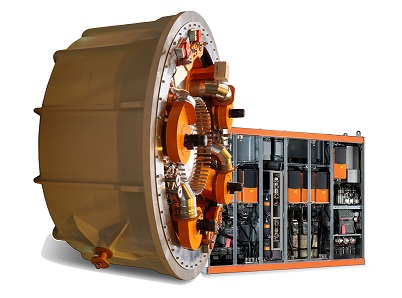This article comes from The Switch

The Switch CEO Jukka-Pekka Mäkinen
As wind and solar compete as serious contenders in generating more energy for the world, the energy produced must be as cheap, if not cheaper, than that of fossil-based sources, and the quality of energy equally as high.
The formula for lowering the cost of energy from any source is ultimately simple: Lower overall capital investment costs, equipment lifetime operation and maintenance (O&M) costs, and fuel costs while boosting the amount of energy generated. This formula becomes even more attractive with wind and solar – because the fuel is already free.
The Switch has taken a closer look at four ways to lower the costs of energy that affect the remaining variables. Here’s how:
A race is on to lower the cost of energy. Although this applies to all kinds of energy, it is even more crucial with new energy sources. To help renewables pick up speed in being accepted, The Switch has considered the key variables that lower the cost of energy production with wind and solar. Here’s what we think:
1. Raise annual energy production
High availability and great efficiency curves make for a winning combination to boost annual energy production (AEP).
Availability
The simplest way to increase AEP is to keep turbines or solar plants up and running. Though the wind and sun may come and go, the equipment must continue to operate and produce a constant stream of high quality energy.
Five years ago, our company made a decision to pioneer permanent-magnet generators (PMG) for wind turbines as its contribution to raising AEP. PMGs are known for their use of permanent magnets, requiring no external power source to initiate a magnetic field. Today, PMG technology is preferred by the market majority because it ensures fewer failures thanks to no wearing parts and less maintenance.
Since 2007, the company has had field-proven experience in offshore wind conditions from its 4.25 MW direct-drive PMG deliveries to ScanWind. These wind turbines have also set significant records in availability. The Switch PMG drive trains typically average 97% availability or higher in all operating conditions.
By minimizing equipment downtime and scheduling regular maintenance and tune-ups for low wind or solar periods, it is possible to keep renewable energy producing equipment operating at its highest availability. The Switch products all feature a highly serviceable design to minimize the need for maintenance and increase production time.
Efficiency
When it comes to efficiency curves, PMGs excel. Operating at peak efficiency or power does not account for better AEP rates. Rather, improved AEP comes from the amount of time a wind turbine spends generating electricity over all wind speeds.
PMGs demonstrate higher efficiency at partial loads where they spend the greatest number of their operating hours, resulting in a proven higher efficiency curve. Moreover, PMGs start producing power at lower wind speeds, letting them add more power to AEP rates.
Each of The Switch’s PMG-based drive trains delivers efficient curves over the entire wind speed range. In an independent study by NextWind’s Rain Byars, the advantage of using PMG becomes clearer at lower wind speeds due to the PMG’s performance capability at partial loads. The use of PMGs result in 1.4 to 6.9% more energy on a consistent basis per year, depending on the wind class.1
2. Minimize total life cycle costs

The Switch manufacturers permanent generators and their controls.
Cutting back on total life cycle costs (TLC) means scrutinizing the expenses associated with both the initial capital investment as well as the O&M costs over the lifetime of the equipment. These two essential expenses must be optimized to bring about the best long-term results.
Capital investment
Going for a low-cost initial equipment investment may not always be wise. In fact, it may even lead to higher hidden expenses when it comes to O&M costs throughout the equipment’s lifetime of 20 years or more.
A double-fed induction generator (DFIG) has been estimated to cost about 30% less in initial investment costs because it uses a partial converter rather than a full-power converter. However, it is important to factor in all additional costs of getting the DFIG connected to the grid according to the latest international grid code requirements, because this may entail more costly connectivity methods and lost production time.
We begin each project with a view to minimize TLC. We start by optimizing the design for each wind and solar customer through our design process that involves close collaboration with customers. Every solution is purpose-built for the specific environment in which it will operate. By placing more focus up front on selecting the right, rugged design, we can significantly lower O&M costs over the equipment’s lifetime.
To lower costs, some designs include magnet placement in the generator to minimize their use, special high-humidity systems to avoid disturbances, and optimized weight-efficiency ratios to best match the desired turbine design.
Operation and maintenance
All solutions from the company require minimal maintenance and feature a serviceable design to speed maintenance routines. When maintenance is scheduled for low seasons in wind and solar, it is cheaper and faster. Moreover, when a recommended maintenance program is followed, it is possible to minimize breakdowns and ensure smooth operation.
Our remote equipment monitoring and 24/7 technical support let customers easily implement a proactive service plan, avoiding unexpected downtime and costly failures. Moreover, PMG technology lets us optimize the entire drive train and offer the greatest possible flexibility to find a solution that reduces O&M costs.
One example of this is the FusionDrive concept, which improves the entire drive train design by removing all high-speed components that are more prone to failure. The lightweight product also saves in tower costs. Another example is direct-drive PMG, which eliminates the entire gearbox, and with it, the slip rings and speed measurements.
When comparing the maintenance costs of a PMG turbine with a DFIG turbine, the potential savings are considerable. The estimated maintenance time between failures (MTBF) for a PMG and full-power converter is 8,000 hours compared to only 1,500 hours for a DFIG.1 In practice, this means servicing once per year for a PMG turbine versus five times per year for a DFIG turbine. The downtime during a maintenance day account for thousands of dollars in lost energy along with associated labor and maintenance equipment costs.
3. Extend the lifetime of equipment
Typical renewable energy generating units, like wind turbines or solar panels, have an estimated operating lifetime of 20 years with today’s technology. By lengthening this time with an additional three to five years, the cost of energy can be lowered significantly. In fact, current designs from The Switch have already been calculated to last longer than 20 years.
A good purpose-built design, well-selected materials and components, and a carefully planned maintenance program can lengthen the lifetime of the equipment substantially. For example, a well-designed drive train minimizes cogging torque, reducing the amount of vibration and lengthening the lifetime of all components.
The Switch has implemented its Model Factory concept, which enables low-cost volume production. This systematic approach allows the consistent, industrialized production of each renewable energy module.
Our proprietary Model Factory concept begins with an optimized supply chain specified by the precise needs of each customer. This guarantees the best possible component quality. It even includes continuous access to critical components, such as the rare earth magnets used in PMG units. Model Factory locations can be flexibly placed wherever needed, even close to the energy generation site. This allows the production of standardized serial products with local expertise and assures the lowest landed cost for each customer.
Another way to extend the lifetime of equipment and increase its production efficiency is through upgrades, retrofitting, and recycling of components. The Switch offers several simple plug-and-play designs to retrofit older DFIG turbines into modern PMG versions that meet the challenging international grid code requirements.
4. Boost the quality of electricity
In the end, the success of renewable energy depends on the quality of electricity it feeds into the grid. News from recent incidents of wind turbines not connected to the grid has overshadowed some of the earlier favorable progress. Now the industry and governments alike are responding – with stricter and more uniform grid code regulations.
Renewable energy products from our company have always demonstrated superior grid connections. Our full-power converters support fault ride-through and fulfill the world’s strictest grid code requirements, including the German BDEW 2008. Our 3-MW units have been tested on site and passed all grid code requirements, even for the latest Chinese regulations. Low flicker, electrical noise emission and THD of <1.5%, the lowest of any in the entire industry, also support the final quality of electricity fed to the grid.
The company believes in the future of new energy as a major contributor to the world’s growing energy needs. But the only way to succeed is to make sure the costs of producing high quality electricity are as low as they can possibly be.
The Switch
theswitch.com
Filed Under: Financing, News, Policy




